August 4 - 10, 2013: Issue 122
Tiny Tiny Birds of Ingleside
Pittwater seems to be attracting more and more birds lately. Returning or permanent wading birds have been spotted this week and the gorgeous tiny birds on this page were everywhere at Ingleside just after dawn on Thursday, August 1st, 2013. They were unafraid of the person behind the camera trying to catch their images, some coming quite close and lingering before flitting very very fast away.
For all of you who wish to learn more about our Pittwater Birds, Kerry Smith of Pittwater Natural Heritage Foundation is offering a Birdwatching and monitoring morning on the Chiltern Track, Ingleside on Sunday 8th of September. It was Kerry who told us a few months ago about the black swans returning to Narrabeen Lagoon and she, along with Marita Macrae, is always generous in helping identify the birds captured by our resident novice.
There will be more beautiful Spring flowers out too then, more then those captured in this week’s parallel celebration of the green and bush blessed hills of Ingleside. This lovely heathland and woodland attracts honeyeaters, whipbirds and many other kinds of birds. Their songs, and being amongst them, is a wonderful experience.
Details: Want to learn about birds?
Meet 8am on Chiltern Rd just north of Cicada Glen Rd ends 11am
Bring: Binoculars, water, morning tea.
To Book: P: Kerry Smith 9944 6271 0402 605 721
Email: pnhabirdwatching@gmail.com
Spotted Pardalote Pardalotus punctatus
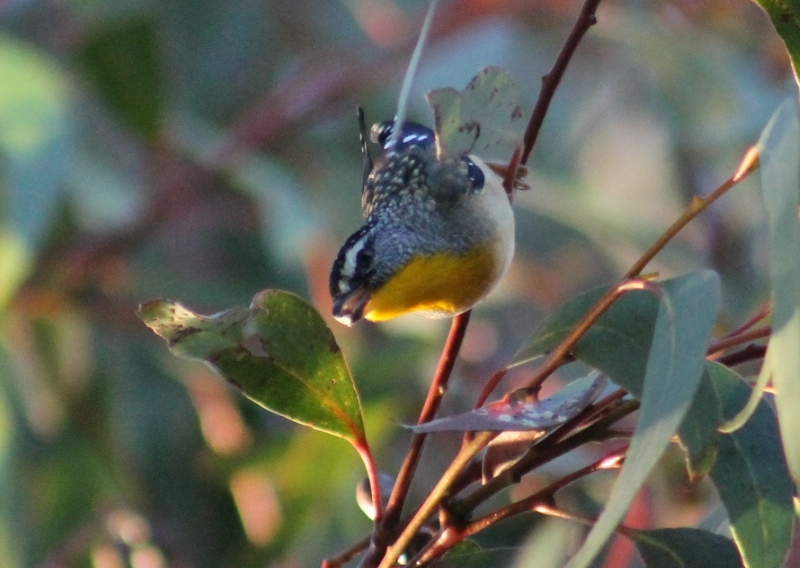
A male Spotted Pardalote. Despite being a bird of the treetops, they nest by digging a tunnel in the side of a bank – Marita Macrae (1.)
The Spotted Pardalote is a tiny bird that is most often high in a eucalypt canopy, so it is more often detected by its characteristic call. The wings, tail and head of the male are black and covered with small, distinct white spots. Males have a pale eyebrow, a yellow throat and a red rump. Females are similar but have less-distinct markings. The Spotted Pardalote uses a tunnel built in clay or soil that ends in a lined chamber, and may ignore the approach of birders. This one photographed this week seemed as curious about the birder as she was of him. Both parents share nest-building, incubation of the eggs and feeding of the young when they hatch.
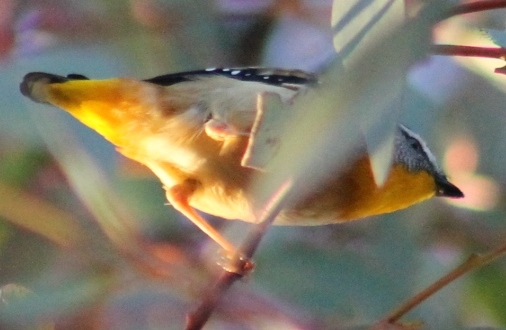
A related Striated Pardalote, P. striatus, has a striped head rather than spotted, and lacks the spotting on the wings and has a plainer back.
They are found in eastern and southern Australia from Cooktown in Queensland through to Perth in Western Australia. It occurs in coastal areas, extending to the western slopes of the Great Dividing Range in the east. Although found mostly in eucalypt forests and woodlands the Spotted Pardalote will also be found in parks and gardens with well-established eucalypt canopy. These beautiful birds are typically sedentary, but may undergo local seasonal movements away from higher elevations in autumn/winter.
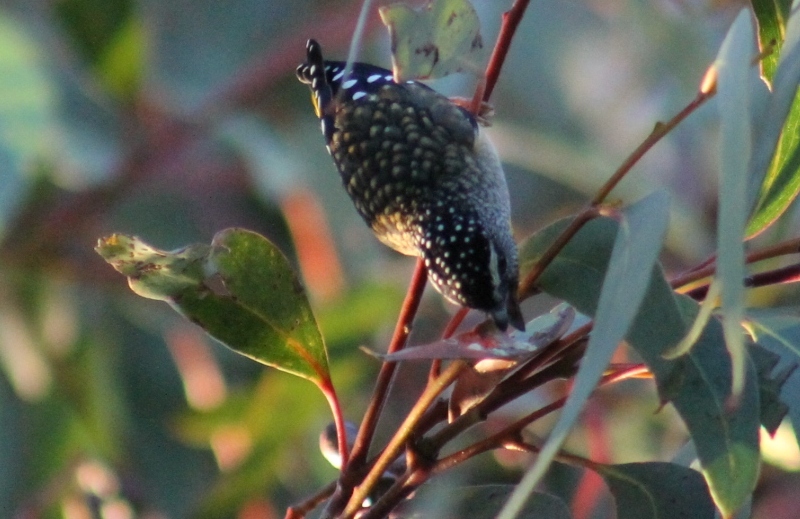
As shown here, the Spotted Pardalote forages on the foliage of trees for insects, especially psyllids, and sugary exudates from leaves and psyllids. The Spotted Pardalote remains relatively common in urban areas that have a high density of eucalypts. Nests have sometimes been found in carpet rolls and garage roll-a-doors. (2.)
Striated Thornbill Acanthiza lineata
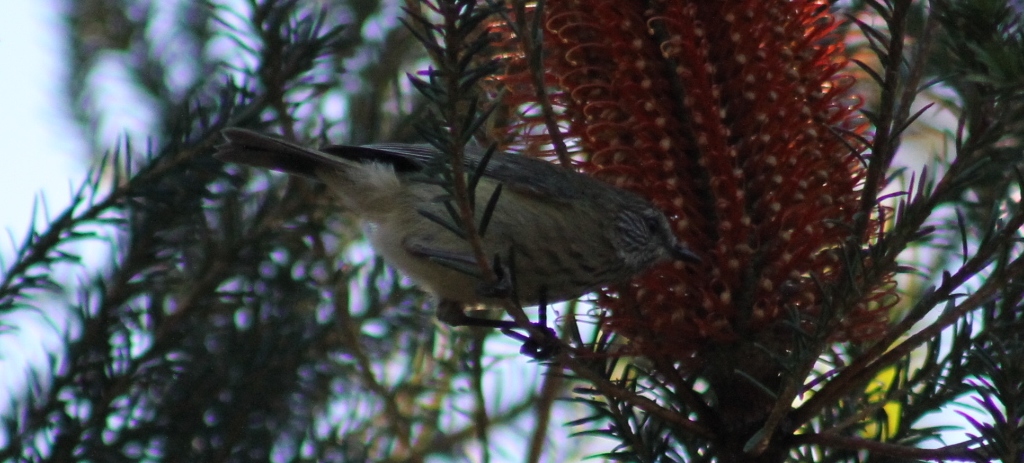
The Striated Thornbill is a medium-sized thornbill with greenish upperparts, an orange-brown cap, streaked distinctively with white and off-white to cream underparts, heavily streaked on chin, throat and breast. The sexes are similar and young birds are only slightly different to adults, with less streaking on the underside.
The Striated Thornbill can be distinguished from the similarly sized and shaped Brown Thornbill, A. pusilla, by its orange-brown cap streaked with white and by black streaking on its yellow-white underparts. In January this year we brought you a page of those Brown Thornbills found happy in the trees beside the yellow brick road at Avalon. It also has a thinner, higher pitched call than the Brown Thornbill and is more commonly found higher in trees. The Striated Thornbill pictured here was photographed at Ingleside and is found only in the south-eastern mainland of Australia from southern Queensland to eastern South Australia.
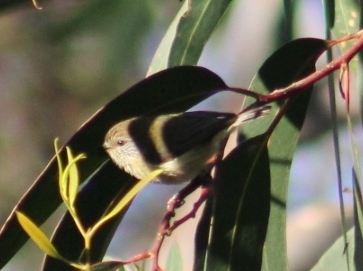 They live in open forests and woodlands, mainly those dominated by eucalypts, with a well-developed understorey. They are sometimes seen in parks and gardens, preferring areas that are more than ten years old and can als be common in agricultural areas, particularly in areas with remnant patches or tree corridors near forests or woodlands.
They live in open forests and woodlands, mainly those dominated by eucalypts, with a well-developed understorey. They are sometimes seen in parks and gardens, preferring areas that are more than ten years old and can als be common in agricultural areas, particularly in areas with remnant patches or tree corridors near forests or woodlands.
The Striated Thornbill feeds mainly on insects, but may sometimes eat seeds, nectar or fruit. They mainly feed in trees in small flocks, but may sometimes feed on the ground. Will be seen feeding in mixed flocks with other small insect-eating birds. Striated Thornbills may be important in reducing psyllid infestations after Bell Miners (which 'farm' the psyllids) have been removed from an area.
Striated Thornbills breed in small related groups, defending a particular nesting territory. Both members of a pair of Striated Thornbills help to build the oval, domed nest, with a hooded entrance near the top, out of bark mixed with lichen, mosses and spider webs and egg sacs (the nest is commonly covered with white material), lining it with feathers, fur or soft plant down. The nest is usually in the outer branches of trees, shrubs and vine-covered saplings, mainly of eucalypts. The female incubates the eggs and both parents feed the young, along with other members of the breeding group. Nests may be parasitised by Horsfield's and Shining Bronze-cuckoos, as well as Fan-tailed Cuckoos. (2.) The Striated Thornbill is adversely affected by logging and eucalypt dieback.
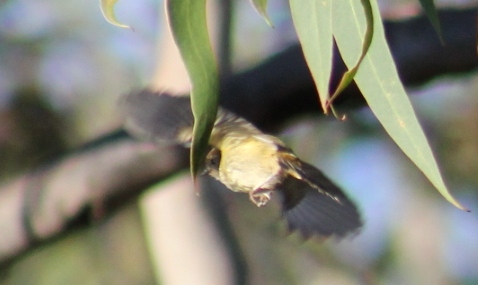
Female Superb Fairywren Malurus cyaneus
The Superb Fairywren, also known as the Superb Blue-wren or colloquially as the Blue Wren, is a passerine bird of the family Maluridae, common and familiar across southeastern Australia. The species is sedentary and territorial, also exhibiting a high degree of sexual dimorphism; the male in breeding plumage has a striking bright blue forehead, ear coverts, mantle, and tail, with a black mask and black or dark blue throat. Non-breeding males, females and juveniles are predominantly grey-brown in colour; this gave the early impression that males were polygamous, as all dull-coloured birds were taken for females. Two subspecies groups are recognized: the larger and darker Tasmanian form cyaneus and the smaller and paler mainland form cyanochlamys.
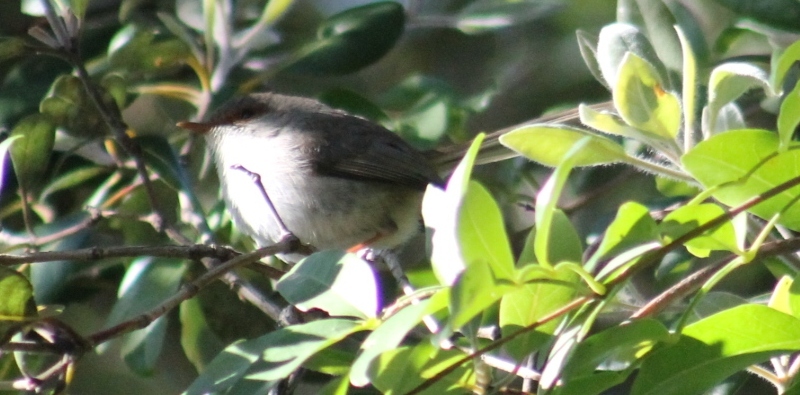
Like other fairywrens, the Superb Fairywren is notable for several peculiar behavioural characteristics; the birds are socially monogamous and sexually promiscuous, meaning that although they form pairs between one male and one female, each partner will mate with other individuals and even assist in raising the young from such pairings. Male wrens pluck yellow petals and display them to females as part of a courtship display.
The Superb Fairywren can be found in almost any area that has at least a little dense undergrowth for shelter, including grasslands with scattered shrubs, moderately thick forest, woodland, heaths, and domestic gardens. It has adapted well to the urban environment and is common in suburban Sydney, Canberra and Melbourne. Last October we brought you a page about the colony at Careel Bay playing fields and they are also seen happy at the beach in the sand dunes of Avalon. The Superb Fairywren mainly eats insects and supplements its diet with seeds. (3.)
References for birds shown here:
1. Marita Macrae
2. Bird in Backyards, Birdlife Australia
3. Superb Fairywren. (2013, April 5). In Wikipedia, The Free Encyclopedia. Retrieved from http://en.wikipedia.org/w/index.php?title=Superb_Fairywren&oldid=548878982



Photos by A J Guesdon, 1st of August 2013.